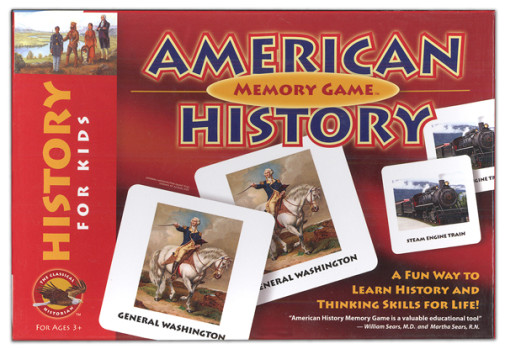We use cookies to make your experience better. To comply with the new e-Privacy directive, we need to ask for your consent to set the cookies. Learn more.
American History Memory Game
Two Games In One:
A. American History Memory: Play the classic matching game. The Player that finds the most matching pairs wins! This is a fantastic game for ages 3 and older.Your child will become familiar with important historical people, monuments, maps, artifacts, and symbols. This game teaches very basic historical facts, image recognition, and memory skills.The tiles are very sturdy and beautiful. After playing with a very young person, he will be extremely interested to learn more about all the images on the tiles.
B. Categories: This game teaches chronology and association skills. Place four Category Tiles (Foundation of the U.S.A., Westward Expansion, The Civil War, Post Civil War) at the top of the playing area. Mix up the 64 Matching tiles. One player says, "Go!" and starts timing. The other player places all tiles under the correct tile. The person with the fastest time wins. For wrong placement, add 10 seconds per tile.This is appropriate for ages 8 and older and requires some knowledge of history. Follow our instructions page for the Answer Key!
Combine gorgeous cards with suggestions for games and you have amazing learning tools. The Classical History card games are just that - gorgeous. Pulling images from classic art, photos of landmarks, symbols, etc., they provide glimpses of history in visual form. There are 48 cards in each Go Fish Game Deck with four options for play: traditional Go Fish!, a categorizing activity, a chronological game, and a geography game. Each card has a photo illustration, three hints, the the title, and a multiple choice section. The Memory Game sets have 64 sturdy cardboard squares (32 pairs). Place them all face down and take turns flipping cards to make pairs. Each card has an image and its name. Each booklet holds additional games for the Go Fish decks. There are Sit Down Games and Motion Games, with playing directions explained for each. The booklets also include a section that explains each card image plus (except for the Constitution booklet) a list of the correct chronology for the cards. ~ Janice
| Product Format: | Card Game |
|---|---|
| Grades: | PK-AD |
| Brand: | Classical Historian |
| EAN/UPC: | 713757180108 |
| Length in Inches: | 5.5 |
| Width in Inches: | 8 |
| Height in Inches: | 1.5 |
| Weight in Pounds: | 0.95 |
Be the first to review this item
This is a memory type of game and can be used with practically any grade level because there are both pictures and writing. The box lists the ages as 3+.


Hands on history review
We have the Ancient and Medieval sets and love them.
We have the Medieval History version and it is FANTASTIC--I've never seen my kids so excited to study history!
Game type learning